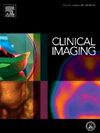低场磁共振成像肺不张严重程度与急性 Covid-19 后患者 DLCO 下降有关。
IF 1.8
4区 医学
Q3 RADIOLOGY, NUCLEAR MEDICINE & MEDICAL IMAGING
引用次数: 0
摘要
目的:评估低场磁共振成像肺不张严重程度的临床意义:评估低场磁共振成像肺不张严重程度的临床意义:对2020年9月至2022年9月期间接受低场MRI成像的急性Covid-19后患者进行回顾性横断面分析,并在1个月内进行肺功能测试(PFT)、6分钟步行测试(6mWT)和症状清单(SI),和/或在3个月内进行圣乔治呼吸问卷调查(SGRQ)。采用 Wilcoxon、Chi-square 和 Spearman 检验进行了单变量和相关性分析。采用混合模型方差分析、协方差和广义估计方程评估了疾病和人口学因素与 MR 不透明严重程度、PFTs、6mWT、SI 和 SGRQ 之间的关系,以及 MR 不透明严重程度与功能和患者报告结果(PROs)之间的关系。采用双侧 5% 显著性水平,并进行 Bonferroni 多重比较校正:共纳入 62 名 Covid-19 急性期后患者(中位年龄 57 岁,IQR 41-64 岁;25 名女性)的 81 次磁共振成像检查。检查时间中位数为首次发病后 8 个月。单变量分析显示,肺不张严重程度与%DLCO下降有关(ρ = -0.55,P = .0125),肺不张严重程度四分位数与%DLCO下降、预测TLC、FVC和FEV1/FVC增加有关。调整性别、初始疾病严重程度和 Covid-19 诊断时间间隔后进行的多变量分析表明,MR 肺不张严重程度与 %DLCO 下降有关(P = 0.0125):低场磁共振成像肺不张严重程度与Covid-19急性期后患者的%DLCO下降相关,但与PROs无关。本文章由计算机程序翻译,如有差异,请以英文原文为准。
Low-field MRI lung opacity severity associated with decreased DLCO in post-acute Covid-19 patients
Objectives
To evaluate the clinical significance of low-field MRI lung opacity severity.
Methods
Retrospective cross-sectional analysis of post-acute Covid-19 patients imaged with low-field MRI from 9/2020 through 9/2022, and within 1 month of pulmonary function tests (PFTs), 6-min walk test (6mWT), and symptom inventory (SI), and/or within 3 months of St. George Respiratory Questionnaire (SGRQ) was performed.
Univariate and correlative analyses were performed with Wilcoxon, Chi-square, and Spearman tests. The association between disease and demographic factors and MR opacity severity, PFTs, 6mWT, SI, and SGRQ, and association between MR opacity severity with functional and patient-reported outcomes (PROs), was evaluated with mixed model analysis of variance, covariance and generalized estimating equations. Two-sided 5 % significance level was used, with Bonferroni multiple comparison correction.
Results
81 MRI exams in 62 post-acute Covid-19 patients (median age 57, IQR 41–64; 25 women) were included. Exams were a median of 8 months from initial illness. Univariate analysis showed lung opacity severity was associated with decreased %DLCO (ρ = −0.55, P = .0125), and lung opacity severity quartile was associated with decreased %DLCO, predicted TLC, FVC, and increased FEV1/FVC.
Multivariable analysis adjusting for sex, initial disease severity, and interval from Covid-19 diagnosis showed MR lung opacity severity was associated with decreased %DLCO (P < .001). Lung opacity severity was not associated with PROs.
Conclusion
Low-field MRI lung opacity severity correlated with decreased %DLCO in post-acute Covid-19 patients, but was not associated with PROs.
求助全文
通过发布文献求助,成功后即可免费获取论文全文。
去求助
来源期刊

Clinical Imaging
医学-核医学
CiteScore
4.60
自引率
0.00%
发文量
265
审稿时长
35 days
期刊介绍:
The mission of Clinical Imaging is to publish, in a timely manner, the very best radiology research from the United States and around the world with special attention to the impact of medical imaging on patient care. The journal''s publications cover all imaging modalities, radiology issues related to patients, policy and practice improvements, and clinically-oriented imaging physics and informatics. The journal is a valuable resource for practicing radiologists, radiologists-in-training and other clinicians with an interest in imaging. Papers are carefully peer-reviewed and selected by our experienced subject editors who are leading experts spanning the range of imaging sub-specialties, which include:
-Body Imaging-
Breast Imaging-
Cardiothoracic Imaging-
Imaging Physics and Informatics-
Molecular Imaging and Nuclear Medicine-
Musculoskeletal and Emergency Imaging-
Neuroradiology-
Practice, Policy & Education-
Pediatric Imaging-
Vascular and Interventional Radiology
 求助内容:
求助内容: 应助结果提醒方式:
应助结果提醒方式:


